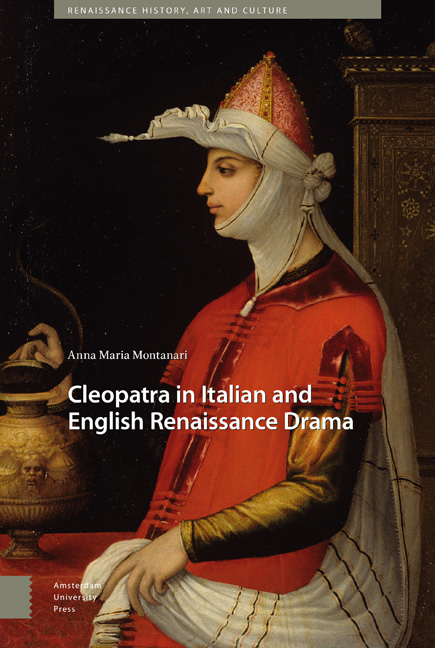Book contents
- Frontmatter
- Dedication
- Epigraph
- Contents
- List of Illustrations
- A Note on the Cover
- List of Abbreviations
- Acknowledgements
- Introduction
- 1 ‘No Humble Woman She’
- 2 ‘The Subject of Talk the World Over’
- 3 The Egyptian Queen's Rebirth
- 4 The Great Theatre of Cleopatra
- 5 ‘The Wanton Luxurie of Court’
- 6 ‘A Lass Unparalleled’
- Conclusion
- Bibliography
- Index
6 - ‘A Lass Unparalleled’
Published online by Cambridge University Press: 21 November 2020
- Frontmatter
- Dedication
- Epigraph
- Contents
- List of Illustrations
- A Note on the Cover
- List of Abbreviations
- Acknowledgements
- Introduction
- 1 ‘No Humble Woman She’
- 2 ‘The Subject of Talk the World Over’
- 3 The Egyptian Queen's Rebirth
- 4 The Great Theatre of Cleopatra
- 5 ‘The Wanton Luxurie of Court’
- 6 ‘A Lass Unparalleled’
- Conclusion
- Bibliography
- Index
Summary
Abstract
Antony and Cleopatra's breach of the neoclassical requirements. Importance of rhetoric in the Renaissance and Shakespeare's peculiar exploitation of it. Antony and Cleopatra and Venus and Adonis. A brief exam of some characters in the play. The manifold aspects of Antony’s personality. The character of Cleopatra. A comparative reading of the queen's apostrophe to the asp. The blending of comedy and tragedy in the play is a conditio sine qua non to its existence. Two contrasting plays (comedy or dark comedy and tragedy) coexist within the same frame. It is only after her lover's suicide that Cleopatra definitively fixes the genre of the play, and she chooses tragedy.
Keywords: Shakespeare; rhetoric; structure; characters; comparative perspective; genre
Dramatist, Actor and Poet
As it has emerged from the previous chapters, the so-called neo-Senecan play, suitably adapted, circulated among privileged social classes and academic and learned groups throughout Europe, despite their various political and ideological backgrounds. Compared to it, home-grown English drama existed in a completely different world. I must of course oversimplify, as it would take far too long to deal with those issues in any detail, in this all-too-short chronological summary. In short, the development of public theatres in London in the sixteenth century (with the consequent professionalisation of actors and dramatists) had created a massive demand for new plays, on the one hand, and on the other had given the popular taste for spectacle and action unprecedented centrality. Acting companies were commercial organisations and competed against one another to gain the favour of paying spectators. The audience was notably heterogeneous: playgoers came from the whole range of social classes, from labourers to craftsmen, from prostitutes and pickpockets to gentlemen. Theatrical drama had to capture the imagination of them all. Classical rules were generally ignored; Seneca was mainly considered a source of gruesome details and bloody revenge motives. Catharsis was not systematically pursued. Action was represented mimetically rather than through narrative. In the works of both resident and nonresident poets myths mingled with folk tales, local legends, and the Bible. As tragedy derived from comedy and in its turn developed out of the mystery cycles, it remained a mixture of farcically comic and tragic scenes, in which kings and clowns happily coexisted.
- Type
- Chapter
- Information
- Cleopatra in Italian and English Renaissance Drama , pp. 211 - 264Publisher: Amsterdam University PressPrint publication year: 2019



